Formula One (F1) racing is one of the most lucrative sports in the world. Have you ever wondered how much the drivers behind the wheel are making? The answer might surprise you. F1 driver salaries have been known to reach the millions, with some of the top earners making over $40 million a year, and that is not the cap. But why are they paid so much? Moreover, from rookies to established veterans, F1 salaries can vary ten and even a hundred times throughout a driver’s career.
The High Stakes and High Salaries of F1 Drivers:
As soon as the driver joined F1, he entered the physically and mentally most demanding sport in the world. The speeds in Formula 1 often reach over 300 km/h. The intense competition in the conditions requires drivers to be always in peak physical condition and to train extensively to perform at their best.
With over a billion audience worldwide, F1 drivers are always at the epicenter of attention. The mental strain of competing in such a high-pressure environment can be intense. F1 drivers must have quick reflexes and be able to handle physical and psychological stress.
So, F1 drivers are paid so much for their top racing skills, physical and mental form, and readiness for the maximal push despite the high risk of crashing. Therefore, the fees of the most legendary drivers may reach an astronomical numbers!
The Highest-Paid Formula 1 Driver of All Time
The top earner in F1 history is Michael Schumacher, who earned over $1 billion in his career. Schumacher won seven world championships and achieved 91 race wins during his career.
Another top earner is Lewis Hamilton, who has won seven world championships and is the current highest-paid F1 driver. In 2019 Hamilton’s salary was estimated to be $55 million a year, making him one of the highest-paid athletes globally.
- Michael Schumacher – $1 billion
- Lewis Hamilton – $489 million
- Fernando Alonso – $320 million
- Kimi Raikkonen – $250 million
- Sebastian Vettel – $240 million
It’s worth noting that these figures include earnings from sources outside of F1, such as endorsement deals and personal investments. However, they still give us a good idea of how much money top F1 drivers can earn throughout their careers.
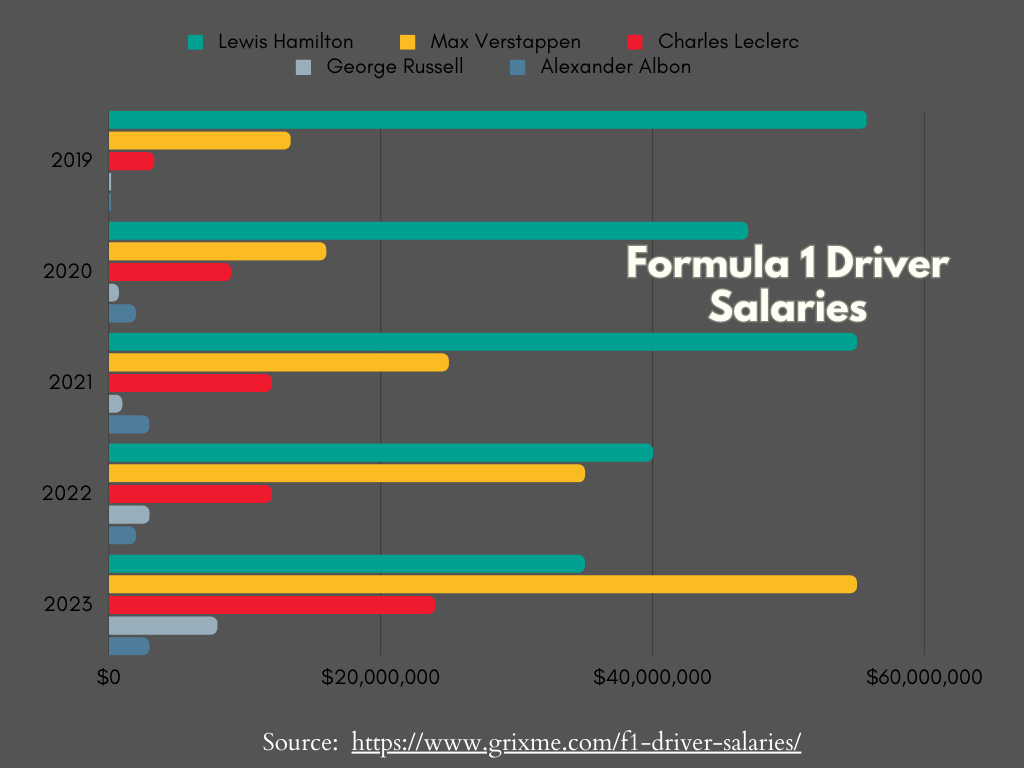
Factors That Affect Driver Salaries
So what factors influence F1 driver salaries? There are several vital factors that teams take into account when negotiating contracts with drivers, including:
1. Performance and Results:
The performance of an F1 driver plays a significant role in determining their salary. Drivers who consistently achieve good results against teammates are likelier to command higher wages. Formula 1 is always about intense competition behind closed doors and friendly relationships in front of the TV cameras. That is what you can see in the system of driver policy in the Red Bull F1 team and its young sister AlphaTauri.
Money fact:
The same year, Alex Albon drove for AlhaTauri and was paid $167,000. However, due to the weak results against teammate Yuki Tsunoda, it was decided that Daniel Ricciardo replace Nyck De Vries in the mid of 2023 season.
Teams are willing to invest in drivers who can deliver success and contribute to their overall performance.
2. Reputation and Popularity:
The reputation and popularity of an F1 driver also impact their earning potential. Drivers with a strong fan following and widely recognized in the sport can negotiate higher salaries due to their marketability.
Money fact:
Despite the Mercedes team struggling with obstacles, Hamilton’s salary for the 2023 season is still very high – $35 million compared with Max Verstappen – $50 million. However, Hamilton’s teammate in Mercedes, George Russell, has only $8 million.
Besides, sponsorship opportunities and endorsements contribute to a driver’s overall income.
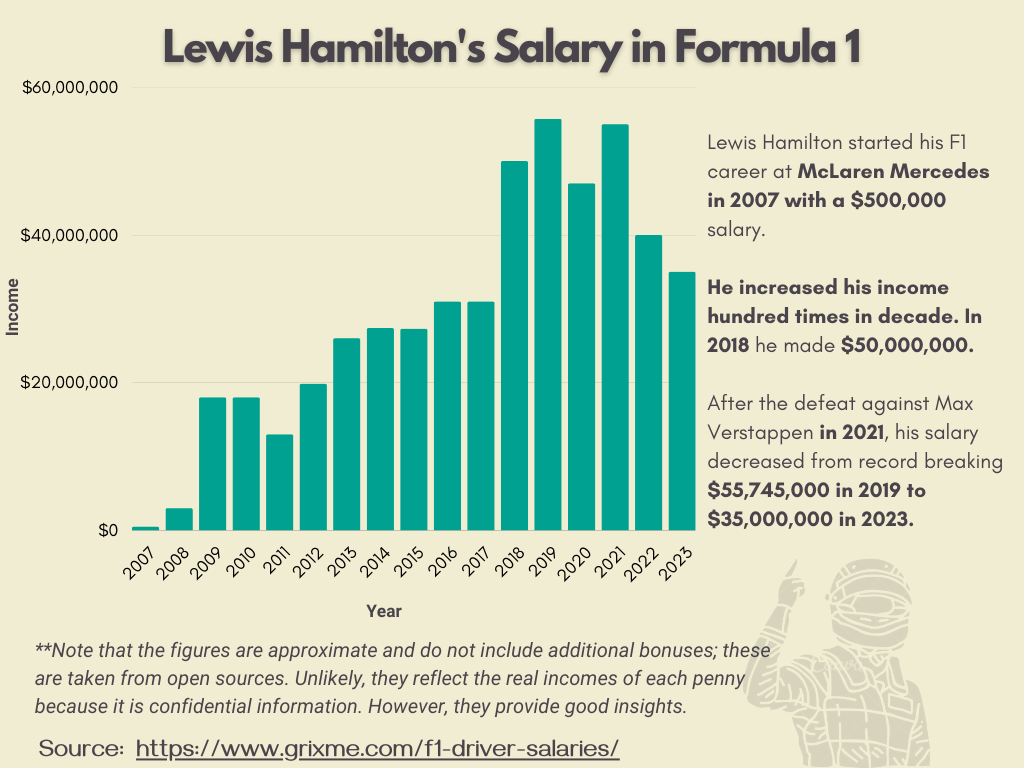
3. Team Budget and Financial Stability:
The financial strength of an F1 team affects the amount. The teams with larger budgets and substantial financial backing can afford to pay higher wages to attract and retain top talent. Conversely, teams with limited resources may have to offer lower salaries to drivers.
Money fact:
4. Negotiation Skills and Contracts:
The negotiation skills of F1 drivers and their agents can significantly influence their salaries. Experienced drivers with a solid track record and strong bargaining power can demand higher salaries during contract negotiations. The terms and duration of the contract also impact the overall package, including base salary and performance-related bonuses.
Speedy fact:
5. Experience and Track Record:
Drivers with a proven track record and extensive experience in F1 are likely to command higher wages comparing rookies or less experienced drivers.
Despite the personal controversies between Kevin Magnussen and Nico Hulkenberg, it was decided in Haas to sign Hulkunbergs. His experiences in Formula 1 played a crucial role in the case.
6. Sponsorship and Commercial Agreements:
F1 teams often rely on sponsorship and commercial agreements to generate revenue. The financial contributions from sponsors can impact the overall budget and, consequently, drivers’ salaries.
Moreover, personal sponsorship plays a vital role for rookie drivers. The leading digital rewards platform Ibotta is the private sponsor of Logan Sargeant.
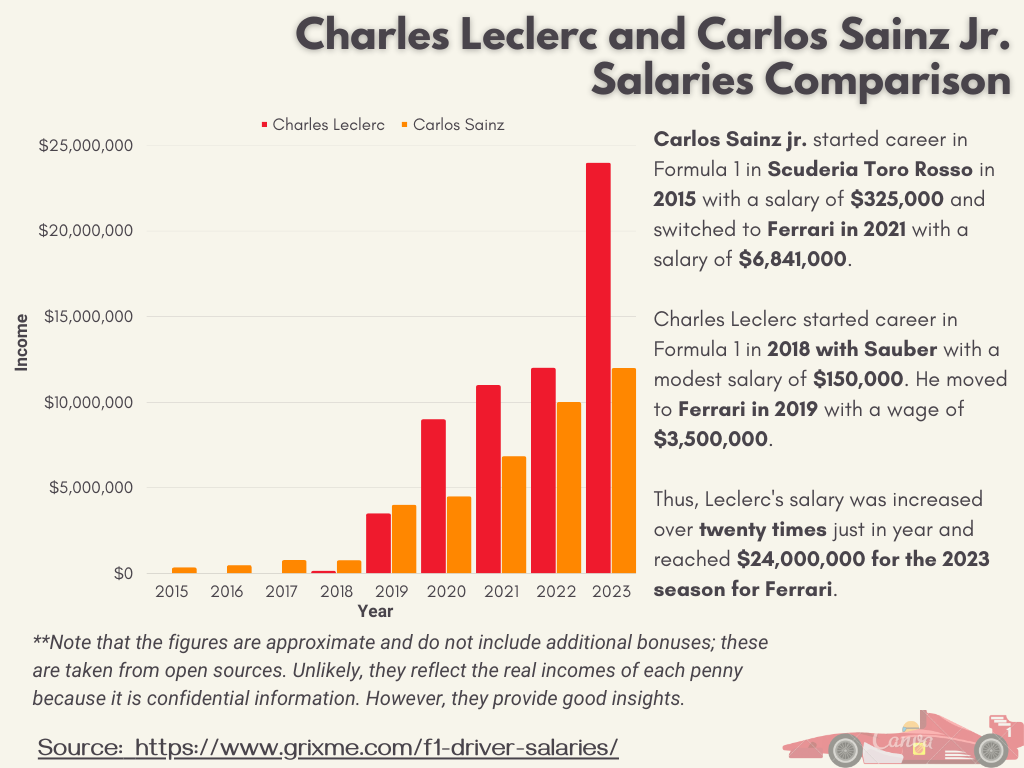
Money fact:
It is important to note that F1 driver salaries are often not publicly disclosed, and the above factors are based on industry knowledge and speculation. The actual amount of a driver’s compensation is negotiated privately between the driver, their agent, and the team and can vary significantly depending on the circumstances and market conditions.
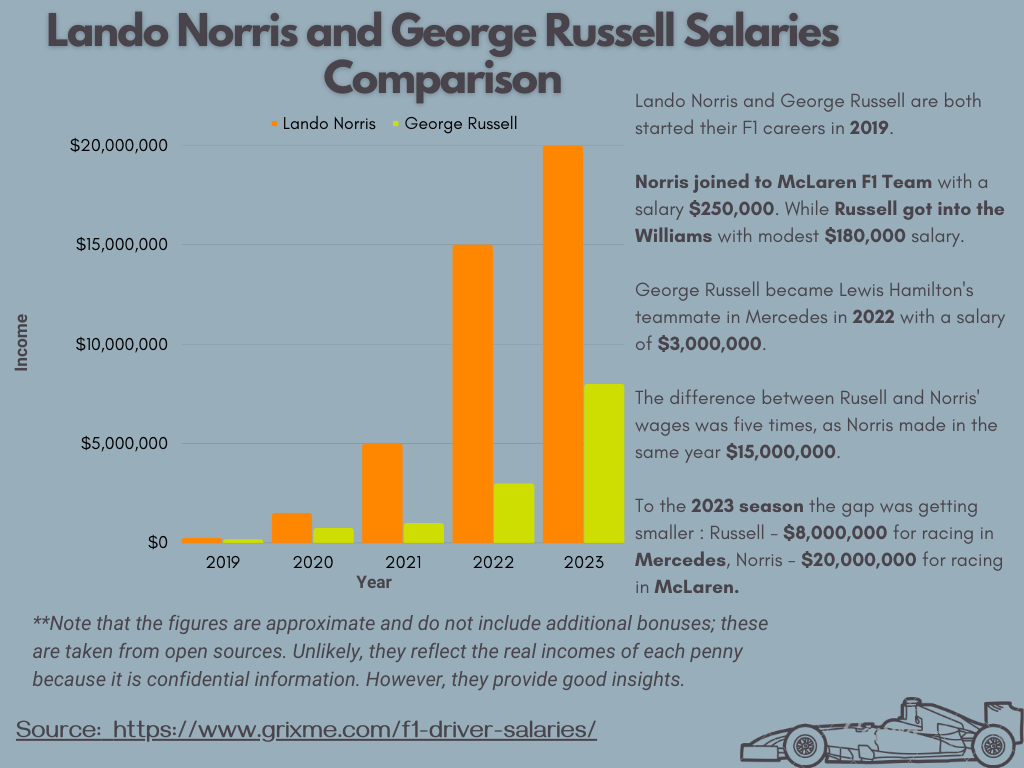
The controversy surrounding F1 driver salaries
The driver salary is a hot topic among the top controversies in Formula 1. Some critics argue that the wages are excessive and that the money could be better spent on other areas of the sport.
However, others argue that the teams and sponsors benefit more from the drivers’ success than the drivers themselves. Formula 1 is a global sport that generates significant revenue, and the drivers’ salaries are a small fraction of the overall earnings.
Comparing F1 driver salaries to other sports
F1 driver salaries may not earn as much as the highest-paid athletes in team sports like basketball and football, but they earn significantly more than athletes in golf and tennis.
According to Forbes, the top five highest-paid athletes in the world in 2023 are:
- Cristiano Ronaldo. Soccer. $136 M.
- Lionel Messi. Soccer. $130 M.
- Kylian Mbappé Soccer. $120 M.
- LeBron James. Basketball. $119.5 M.
- Canelo Alvarez. Boxing. $110 M.
As Lewis Hamilton and Max Verstappen set at only 21st and 22nd places, F1 drivers don’t quite make it into the top five, but they’re close.
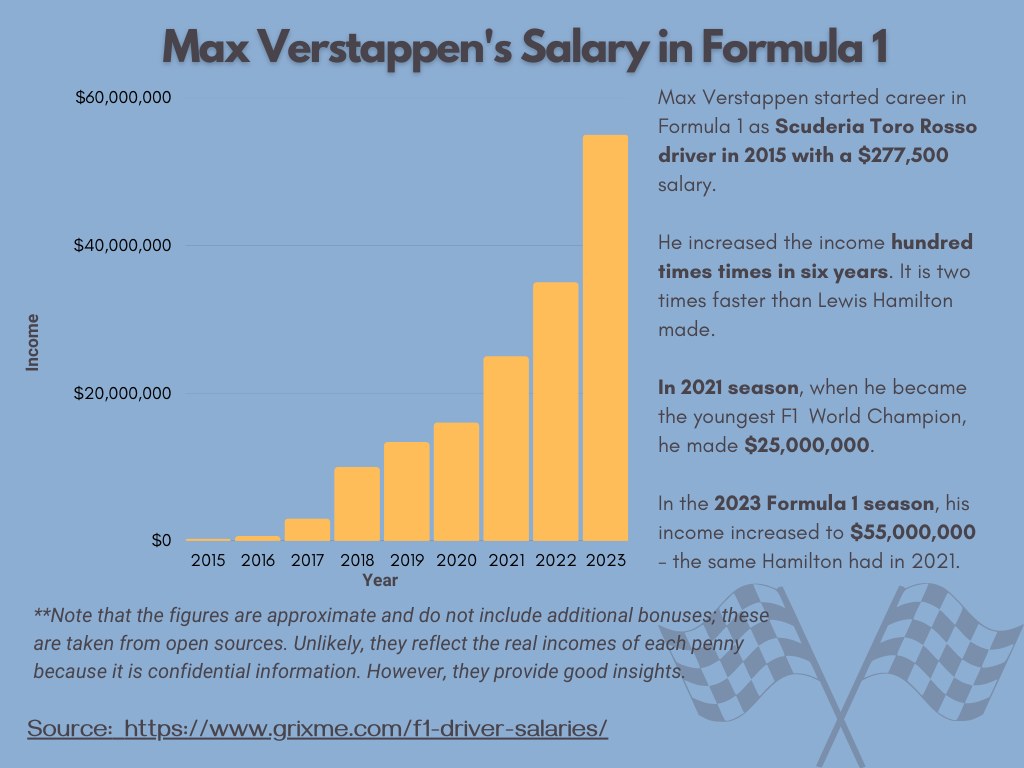
Rookie Driver Salaries
Rookies F1 drivers can generally earn anywhere from $150,000 to $500,000 annually.
However, another point is the unfair salaries between drivers on the grid. Thus, having equal features, drivers make different money in one team. Also, there is no difference in the training and risks between rookie and top-tier drivers in Formula 1, while the salary gap between them is 50 times.
Of course, this is still significant, but it pales compared to what top drivers earn. However, for many rookies, simply getting a foot in the door of F1 is a dream come true, and they’re willing to take a lower salary to prove themselves on the world stage.
Mid-level Driver Salaries
Once a driver has a few seasons of experience, they can expect their salary to increase significantly. Mid-level drivers can earn anywhere from $1 million to $10 million per year, depending on their level of success and the team they drive for.
At this stage in their career, drivers are expected to be competitive and consistently finish in the points. They’re also likely to have secured sponsorship deals, which can add millions of dollars to their annual earnings.
Top-tier Driver Salaries
For top-tier drivers, the sky’s the limit to earnings. The highest-paid F1 drivers can earn upwards of $50 million annually due to performance bonuses, sponsorship deals, and base salaries.
These drivers are the crème de la crème of the sport, and they’re expected to consistently challenge for race wins and championships. They’re also likely to have a massive following of fans, which can make them even more attractive to sponsors.
From Racing to Riches: The Lucrative World of F1 Driver Salaries
F1 drivers can earn income from salaries, winnings, sponsorships, endorsements, and merchandise sales. Salaries come from their race teams and range from hundreds to millions annually. Winnings come from the prize money awarded for winning or placing in a race.
Sponsorships and endorsements come from major brands and companies that want to be associated with the driver and the sport of F1 racing. Merchandise sales come from selling apparel and other items with the driver’s logo or team colors.
For example, Lewis Hamilton’s love for fashion brought him a “modest” income. He has collaborated with Tommy Hilfiger since 2018. Today, Mercedes driver has endorsements with Petronas, Sony, Bose, Bell Helmets, MV Augusta Motorcycles, Monster Energy, Puma, IWC, and Gran Turismo Sport. He is also sponsored by Bose, Mercedes-Benz, Sony, Police, and Vodafone USD. Through these deals, he makes $8 Million in endorsements annually.
Red Bull driver Max Verstappen has signed a personal endorsement deal with brewing giant Heineken.
Charles Leclerc is backed by Scuderia Ferrari, Richard Mille, and Giorgio Armani brands. Thus, participating in the promotional events allow Leclerc to make the additional bonuses to his salary.
F1 Driver Salaries for the 2023 Season
Red Bull
Max Verstappen, the youngest F1 champion, earns $55 million.
Verstappne’s teammate, Mexico’s Sergio Perez, makes $10 million
Ferrari
Charles Leclerc, potential F1 champion, has an estimated worth of $24 million.
His teammate Carlos Sainz Jr. is estimated to be worth $12 million.
Mercedes
Lewis Hamilton, the racing star and the most influential athlete on the grid, has an estimated earning of $35 million.
His teammate, George Russell, one of the most talented racers, earns around $8 million.
Alpine
Popular French driver Esteban Ocon earns $6 million.
His new teammate, ex AlphaTauri driver, Pierre Gasly, earns $5 million.
McLaren
The F1 racing star, Lando Norris, holds a net worth of $20 million
His new teammate and rookie of the 2023 season, Oscar Piastri, has an estimated net worth of $2 million.
Alfa Romeo
Former Mercedes driver Valtteri Bottas earns $10 million.
His teammate Zhou Guanyu makes $2 million.
Aston Martin
Two-time F1 world champion and the most experienced driver on the grid, Fernando Alonso, has an annual salary of $5 million.
His teammate Lance Stroll makes $2 million annually.
Haas
One of the experienced drivers, Kevin Magnussen, earns $5 million.
Finally returned to the Formula 1, Nico Hulkenberg brings in $2 million.
AlphaTauri
Young rising star Japanese driver Yuki Tsunoda makes $1 million.
Former F1 driver and current Formula E driver Nyck de Vries had to make $2 million.
Another returned F1 star, Daniel Ricciardo, who replaced Nyck de Vries, already had a contract as a reserve driver for $2.1 million. But hence he took behind the current car wheel, the numbers have to increase by 1.5 times, as we expect.
Williams
Rising star Alex Albon has a $3 million salary for the 2023 season.
Popular American driver Logan Sargeant earns $1 million.
Concluding
F1 driver salaries are undoubtedly high, but they reflect the value of the skills, experience, and risks that drivers take. The highest-paid F1 drivers of all time have achieved multiple championships and become household names in the sport. Factors like team success, individual success, and sponsorships all contribute to the high salaries of F1 drivers.
While there may be some controversy surrounding these salaries, these reflect the high stakes in F1 racing, where the difference between winning and losing can come in seconds. As the sport continues to evolve and grow, we can expect driver salaries to keep rising, making F1 one of the most lucrative sports in the world for top athletes.

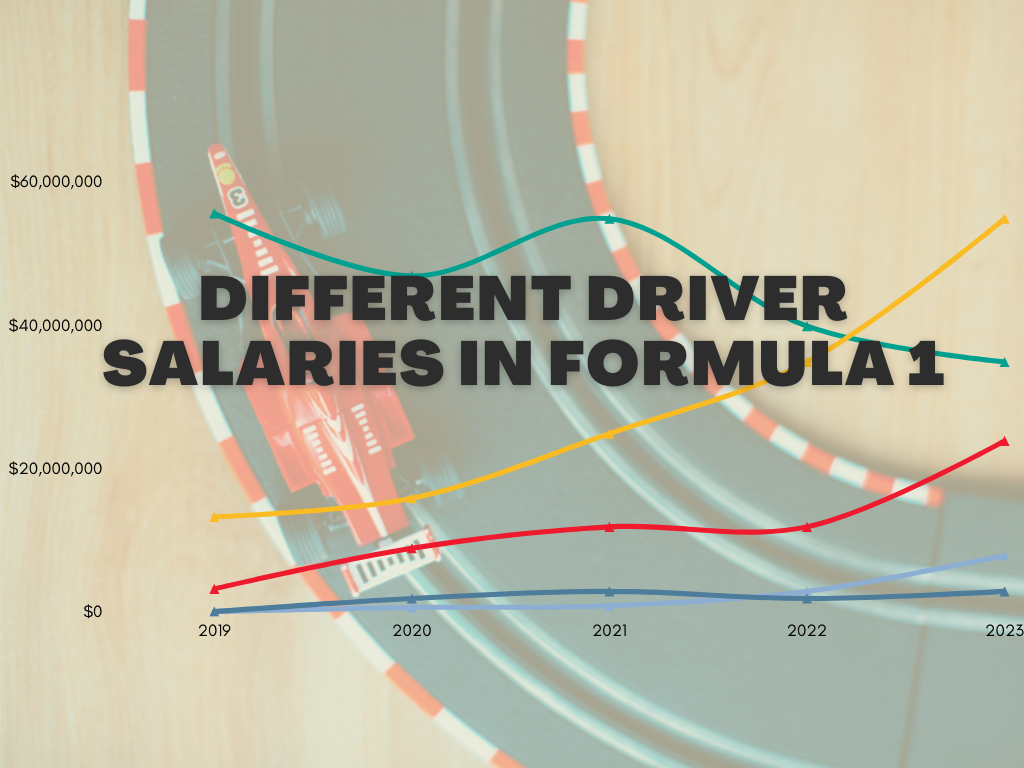

Leave a Reply